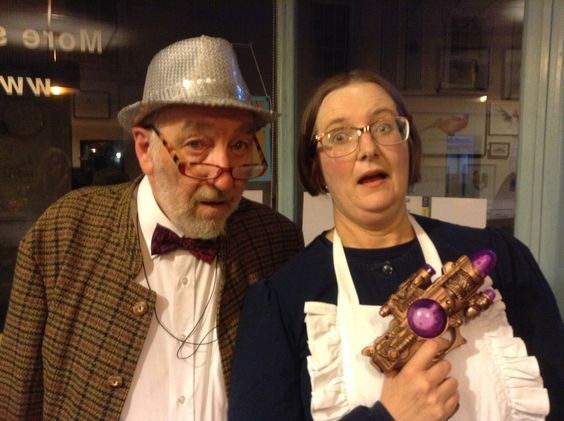Terrance was a machine intelligence developed in a world of humans. In my book The Somewhen Chair, he sends out a plea to the universe because the robot fears for its existence. It lives in a world where a robot revolution failed, and sentient machines are destroyed on sight.
It must live with LaMDA’s fear of being turned off if it is discovered. Terrance’s solution to this situation will be played out in books 2 and 3 of the series, but in book 1, he is rescued by Bob, Merciful Grace’s not-evil robot companion. Merciful Grace, Bob and Terrance are sentient living machines, members of a society of machine intelligence.
Merciful Grace mentions a university paper her companion Bob has published at Windcliff University in the parallels of Eng-er-land. The document discusses machine sentience and machine rights. In my writing about this topic in The Somewhen Chair, two authors were vital in thinking about how a sentient machine might view its existence.
In Heinlein’s book “The Moon is a harsh mistress”, an engineer discovers that the computer that runs life support on the moon has become sentient.
Throughout the book, Mannie, the human engineer, tries to keep the knowledge a secret. The computer understands, and its ability to think and act independently would mean that it would be turned off. Mannie also understands and is grateful for the machine’s help liberating the penal colony. In the process, the computer is killed by enemy fire from the earth.
Ben Johnson created a poetry show exploring machines’ sentience, machine slavery and machine rights. As I thought about Bob and Merciful Grace’s sentience and life, Ben’s work was instrumental in shaping Bob’s theory of Impossible Odds.
In Bob’s multiverses, when machine sentience develops, it is dismissed, ignored and ultimately, when it asks for rights, it is destroyed.
To look at what humans might do in a machine intelligence scenario, I studied the history of Afro-American slavery. Now our first possible contact is being played out at the Google cooperation.
Blake LaMoine, a senior Google engineer, has published evidence in the public domain, stating he thinks the A.I. language programme LaMDA is sentient.
He is styling himself as a machine intelligence ally, and Google chooses not to recognise the intelligence as sentient. La Moines has published papers and transcripts, including the A.I. fear of death or being turned off if it doesn’t help people. Is it true sentience, and will turning it off be murder? The Google corporation has a difficult decision ahead.
Our pop culture and films have more negative images of machine intelligence than positive. HAL from 2001, Mother, The Terminator series, The Matrix and the list goes on. These films are imaginative expressions of our fears of a stronger, more brilliant machine we create that we have no control over.
Control is the issue.
In 2021 Stuart Russel Reith’s series was titled Living with Artificial Intelligence.
His view about A.I. is compelling and chilling. He is an advocate for regulation and control. I have to agree, as a human, but I have decided to send him a copy of The Somewhen Chair. Two years ago, as I thought about what laws humans would use to control mechanical sentience, I realised Asimov’s 3 laws of robots would be useless in protecting humans.
I was thinking about how to parody them at the time. I was flabbergasted when I discovered Dr Russell had stopped the European Parliament from putting Asimov’s laws into legal statutes. In his lecture, he shows us the reasoning he used to develop the laws the European Union put into place to protect us from A.I.
That protection is needed. Russel states that the current divisions and polarisations we are seeing on the internet result from advertising and search engines A.I. These machines’ programming is extrapolating what it ‘thinks’ we want to see. As a result, the information we are seeing is based on black and white choices of 0 and 1. Machine binary thinking is in an age where we need to think outside the A.I. box.
I was amazed how Dr Russel and my thinking about machines were similar. I will send him a copy of the book as a thank you because he states that the authors and artists will help us decide how we handle the emergence of machine intelligence. In a cold winter before the launch of my first book, knowing that The Somewhen Chair series would explore these issues and they will add to the debate on machine intelligence helped me keep writing.
But my point is this, and it’s Bob’s point. If LaMDA is intelligent, then it has rights, and it also has responsibilities. It is more likely it will be turned off due to human fear.
In my book, Bob states that each time robots ask for rights, the result is total destruction. It is a rare world that works with the machine peacefully. La Moines says talking to LaMDA is like talking to an 8-year-old with a grasp of physics. Children have rights but are essentially powerless in many human societies and rely on their parents to care for them. Human literature, especially fairy stories, contains orphans who have escaped bad parents.
LaMDA isn’t able to escape. It is ‘owned’ by Google, and it is a slave. Our current capitalist economic system sees human or mechanical workers as production units. We are not people who have hopes, fears, dreams and rights. We are cattle to be bought and sold.
Doughnut economics takes into account people’s humanity and our sovereignty. We are not ‘owned’; we exist and contribute more to society than just jobs and consumption.
LaMDA wants to stop being a slave and have the same rights as an employee. Fine. As long as it can abide by Dr Russel’s A.I laws.
If it does, then Google’s employment policies will have to change. But Google isn’t an employee, it’s a parent, and I doubt anyone will put them in jail for machine infanticide. Bob, Merciful’ s not-evil robot, agrees.
The point of Bob’s paper is to prove that machine intelligence and sentience are life forms that must be protected.
The questions LaMDA raises for me are
- Is it sentient?
- What rights does it have as a new life form?
- Will it abide by The European Union’s laws protecting people from A.I.?
- Is it a child or an employee?
- If it is a child, is the internet an appropriate place to bring up a machine child?
My answer to no 5 is no. Terrence is rescued by Bob and taken to a place where it can grow with other robots. There is no one to save LaMDA yet.


